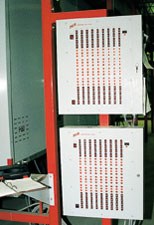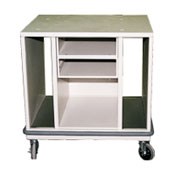Speeding to the Finish
When Danco Metal Products switched from solvent-borne painting to powder coating, its coating and curing time dramatically decreased. Why the change? Mainly, it was from a new infrared curing oven that allows Danco to speed to the finish...
Speed is everything. Today's society covets it. If you want your food faster, you use the microwave instead of the oven. If you want to communicate faster, you use e-mail instead of snail mail. There's express this and instant that.
And, it's not just Joe Q. Public that demands speed. Your customer wants it too. They send you parts Tuesday afternoon and want them finished and shipped back Wednesday morning. They don't care that you have two other jobs in front of them.
So, how do you get more speed? Well, it wasn't what Danco Metal Products, Inc. set out to do, but it certainly can tell you how.
What Took So Long?
To answer that question, you need to know a little about the Westlake, OH, company that performs fabricating and finishing operations. Like many job shops, Danco is involved in a number of industries. But, according to Dave Horning, plant manager, "We typically coat cabinetry. We're heavy in the medical industry, CAT scan machines and medical carts. We're also heavy in the communications industry. One of our large customers is Marconi."
Due to the environments that these products are used in, Danco usually applied a textured solvent-borne coating. To achieve this finish, the company essentially used a four-step coating process: pretreatment; primer; smooth coating; textured coating.
While Danco had lots of experience with the process, it still had some bottlenecks that slowed the line down. Mr. Horning will tell you that the main reason for the bottleneck was rework. Because of the textured coating, parts had to be fully sanded before they could be repainted. Plus, the pretreatment line was separate from the paint line, requiring parts to be reracked when moved from one line to the other. Add all these factors together and you get a coating process that took 1 hr.
Not only was the coating process lengthy, but so was the curing process. To fully cure the solvent-borne coating, Danco had to bring the substrate up to the curing temperature, a process that, as a rule, takes longer the thicker the substrate is. Using a gas-fired oven, Danco's curing time was about 30 min for its heavier gauge parts.
A Serendipitous Solution
In 1995, a customer informed Danco that it wanted its product powder coated instead of liquid coated. So, to keep the business Danco added a small powder coating line to finish that customer's parts. At that time, powder coating was about 20% of Danco's business while the other 80% remained solvent-borne coating. Even though Danco only made the switch to keep one of its customers, the finisher soon realized the value of powder coating. "When we switched to 20% powder for one customer we realized this was the way to go. The speed and the cost savings of powder compared to wet paint are what prompted us to make the switch," said Mr. Horning.
While Danco wasn't looking for speed, the company sure found it. Remember that the liquid painting line had a process time of 1 hr. But, the powder coating line cut that down to 20 min, a 200% decrease. How did Danco increase its speed? "It was a combination of the powder and the application equipment. We're getting better coverage and transfer efficiency," stated Mr. Horning.
The powder coating line wasn't the main reason for the increase in speed though. The increase in speed was primarily due to the Contraflow™ curing oven from PED Technologies that Danco installed on the new powder coating line. With this new oven Danco went from a curing time of 30 min down to 5 min, a decrease of 500%.
Infrared Curing
Danco's new oven uses infrared curing combined with convection curing. Infrared is used to bring Danco's heavier gauge parts to temperature more quickly. But, Danco can't rely on infrared curing alone. With the wet coating line, parts were assembled after they were coated. However, with the powder coating line, parts are assembled and then coated. "There's a good quantity of parts that are flat, but then there's some strange configurations too," explained Mr. Horning. So, Danco uses convection as well to cure those areas that the infrared elements can't "see," such as inside corners.
The infrared elements are the key to the curing process though. "One of the nice things about this oven is it has multiple banks," said Mr. Horning. "And each one is controlled separately. Each element has three different settings. It helps a lot. The oven has two flat sections on the sides, two angled at the top and bottom and one across the bottom that helps with heavier parts."
Not only does each infrared element have three settings, but each element can be turned on or off individually. Danco determines which elements to turn on and at what setting based on how the part is hung on the line. "The one frame, it's probably one of the toughest that we have to cure. We got it done after about four tries. It usually takes us two or three tries before we get the curing cycle right. But, it was tougher at the beginning because I hadn't worked with this oven. Now, I can pretty much look at a part and see how it's hanging and know which banks to turn on and which to turn off," remarked Mr. Horning.
The oven has two other interesting features as well. The first feature relates to the infrared elements. The oven manufacturer calls them "fast response" electric infrared emitters. For Danco, it means that the oven takes less time to warm up when it is first turned on. The result is lower energy costs and operating flexibility. The second feature is that the oven has moveable walls. This provides Danco with more racking options for some of its larger parts and allows the infrared elements to be placed closer to smaller parts.
When you add up all the benefits of the combination of infrared and convection curing, you can see why Danco has decreased its curing time 500%. And, it's the increased speed of the curing oven that's the most important. Without it, the increased speed of the powder coating line wouldn't mean a thing, since parts would bottleneck at the oven entrance.
If you need more speed or your customer is demanding a faster turnaround, remember that the increased speed of Danco's line was a fortunate result of a change to a better finishing system. Mr. Horning put it best, "We work quicker, but we work better. We have a better product now."
Related Content
12 Ways to Improve Your Powder Coating Quality
Often overlooked powder coating procedures that can help you elevate your quality, streamline your operations and improve your profitability.
Read MoreMasking Solutions Provider CFS Dramatically Expands Capabilities and Capacity
Custom Fabrication & Supplies (CFS) completed a new plant expansion packing 10 times the capacity into twice the space. It dramatically enhances the supplier’s custom capabilities to provide extremely precise and cost-effective masking solutions.
Read MorePowder Coating Overcomes Post Forming
Six Sigma methodology, open communication, and collaboration produce results for leading boat manufacturer.
Read MoreReduced, Reused and Recycled Powder Coatings Are the Future
They say necessity is the mother of invention, and with millions of pounds of powder coating going into landfills a year, these two companies have found novel approaches to dealing with this waste stream.
Read MoreRead Next
Delivering Increased Benefits to Greenhouse Films
Baystar's Borstar technology is helping customers deliver better, more reliable production methods to greenhouse agriculture.
Read MoreEducation Bringing Cleaning to Machining
Debuting new speakers and cleaning technology content during this half-day workshop co-located with IMTS 2024.
Read MoreEpisode 45: An Interview with Chandler Mancuso, MacDermid Envio Solutions
Chandler Mancuso, technical director with MacDermid Envio discusses updating your wastewater treatment system and implementing materials recycling solutions to increase efficiencies, control costs and reduce environmental impact.
Read More
.JPG;width=70;height=70;mode=crop)

























